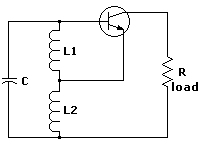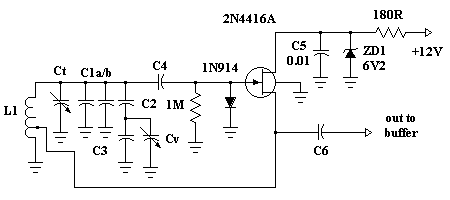
Fig 1.
Some people regard the design of RF Oscillators to be something
akin to a "black art" and after many years of swearing at "cranky" oscillators
I'm not all too sure they are all that wrong. I suggest you ensure you
remember this old saying:
When I was a kid, yes I can remember back to the late 1940's, we collected all manner of junk. Cool was anything remotely electrical and, of course bicycle dynamos, lamps or motors were even "extra cool".
We as precious little seven year olds conceived - all budding nuclear
physicists that we were - of this real smart idea, obviously nobody had
ever thought of this before.
"Why don't we connect a motor to a generator, so the motor drives the generator, providing electricity for the motor, which continues to drive the generator and it'll go on, and on, and on for a hundred years and we'll become world famous!"
Of course we had no concept of frictional losses (I think that's right) way back then. Nor had the words "perpetual motion" passed our ears.
The whole point of that little story is to crudely demonstrate the principle of how an oscillator works. If you can follow that childishly naive concept then you will kill them in this.
Every oscillator has at least one active device (smarties don't complicate matters for me - just read on) be it a transistor or even the old valve. This active device and, for this tutorial we'll stick to the humble transistor, acts as an amplifier. There is nothing flash about that. For this first part of the discussion we will confine ourselves to LC Oscillators and I'll keep the maths to an absolute minimum.
At turn on, when power is first applied, random noise is generated within our active device and then amplified. This noise is fed back positively through frequency selective circuits to the input where it is amplified again and so on, a bit like my childhood project. Ultimately a state of equilibrium is reached where the losses in the circuit are made good by consuming power from the power supply and the frequency of oscillation is determined by the external components, be they inductors and capacitors (L.C.) or a crystal. The amount of positive feedback to sustain oscillation is also determined by external components.
I decided to lead off with this one for the simple reason it's my favourite. Recently it was discussed that your favourite oscillator was likely the one which worked best for you and I think that is quite true. So here it is in it's most simplified form.

The basic Colpitts oscillator circuit look like this and you will see some similarities.

If you consider positive feedback is applied to compensate for the losses in the tuned circuit, the amplifier and feedback circuit create a negative resistor. When Z1 and Z2 are capacitive, the impedance across the capacitors can be estimated from a formula I won't lay on you here because it includes beta, hie, as well as XC1 and XC2. Suffice to say it can be shown that the input impedance is a negative resistor in series with C1 and C2. And the frequency is in accordance with:
Frequency or phase stability of an oscillator is customarily considered in the long term stability case where frequency changes are measured over minutes, hours, days even years. Of interest here are the effects of the components changes, with ambient conditions, on the frequency of oscillation. These might be caused by changes in the input voltage, variations in temperature, humidity and ageing of our components.
Never underestimate the effects of these variations on the frequency of operation. I've gone nuts working on so called precision designs, with precision components, where the frequency wandered at random over several kilohertz over several minutes. Needless to say I'd "messed up".
Short term stability is also of great interest and, again I could lay some real heavy maths on you but I won't. I'll simply say it can be mathematically proven that the higher the circuit Q, the higher this stability factor becomes. The higher the circuit Q, the better the ability the tuned circuit can filter out undesired harmonics AND noise.
A frequency change of a few tens of hertz back and forth over a couple
of minutes would mean nothing to an entertainment receiver designed for
the FM Radio band. Such a drift in an otherwise contest grade receiver
designed to receive CW (morse code) would be intolerable. It's a question
of relativity.
These are random and not in any particular order.
So there are some of the things to keep in mind. Hopefully at this point you have discovered the broad idea of an oscillator, I've outlined broadly two types Hartley and Colpitts. I spoken about frequency stability and listed ways to combat phase noise and reducing frequency drift. Now let's proceed to the main course.
Here I'll present the schematic for my old favourite, together with a buffer stage and an amplifier stage which should deliver about 5V P/P into a 50 ohm load. We'll discuss each relevant stage and produce some rule-of-thumb design info. Because the consensus comes down in favour of FETS and I'm big enough to lay aside my prejudices in the noble cause of advanced education we'll use a FET oscillator. Nothing to do with a few friends who might belt me up!

For this design I'm going to say we will be constructing a general purpose VFO to operate at 5000 - 5100 Khz no particular reason, pick anything you like.
Now I chose a 2N4416A FET purely because I bought a big bag of them years ago and have them on hand. You could use any general purpose JFET you can readily obtain. Note the 2N4416A is a metal can and the case is grounded.
The frequency determining components are L1, Ct (a nominal 10 pf trimmer), C1a, C1b, C2, C3, Cv and C4.
Note: I have been asked a number of times the function of C4 in this circuit. Capacitor C4 is to reduce the loading on the tuned circuit components. It may be as small as possible consistent with being able to provide sufficient drive to the succeeding buffer amplifier stage. Often the home constructor will often make C4 a trimmer.
The other components are bog standard. The two resistors, silicon diode
and zener diode need never change, capacitor C5 is about right for this
frequency. C6 can be selected to give higher / lower output to the buffer
amplifier. Smaller C6 values give lower output and conversely higher values
give larger output.
The silicon diode I'll explain later, the zener diode is to give a
regulated 6.2 volt supply
Now there is NOTHING sacred about my frequency determining capacitor combination O.K.? Too many people look at these kind of circuits and think they must duplicate everything literally, not so. This is just a typical representation. C1 to C3 plus Cv and Ct are just a combination of parallel and some series capacitors all designed to give us a bit of flexibility with the tuning range. Cv could easily be replaced by two back to back tuning diodes.
What you need to do to get the circuit to work is to have an inductive reactance for L1 of around about 180 ohms. At 5 Mhz this works out at about 5.7 uH and, if you don't know how I arrived at that figure I seriously recommend you spend some time on my other tutorials on my new site such as Basics and LC Filters.
The important aspect is that the feedback point from the source of the JFET connects to about 25% of the windings of L1 from the ground end. Now I've depicted an air cored inductor. It could be, just as one example among a great many, 18 - 19 turns of #20 gauge wire on a 25.4 mm (1") diameter form spread evenly over a length of about 25.4 mm (1"). The tap would be at about 4 1/2 turns. Check that out with the formula's I taught you elsewhere.
Alternatively, with degraded performance, you could use a T50-6 toroid and wind say 37 turns of #24 wire (5.48 uH) tapping at 9 turns. The AL factor for a T50-6 is 40. Again do the other tutorials if necessary, I'm not going to repeat old work and it's going to be even harder from here on. I'll thoroughly explain new concepts, not the old.
So if we are to have our oscillator working at about 5 Mhz, we know the LC is 1013 and if L is say 5.7 uH then total C for resonance (just like LC Filters eh!) is about 177 pF. We want to be able to tune from 5000 to 5100 Khz a tuning ratio of 1.02 which means a capacitance ratio of 1.04 (min to max.).
Let's fiddle with some numbers! I have a Jackson Bros. air variable capacitor (very Rolls-Royce) which swings from 10.5 pF to 105 pF, a typical 10:1 ratio in air variables. This I will use for Cv.
If the total swing is 1.04 (actually 1.0404:1) and Cmax is 177 pF it follows Cmin is 170 pF. A variation of only 7 pF (roughly). Now we're treading on unsafe ground here with such a large variable capacitor. We could:
A) rip plates of it to reduce capacitance (don't
even think about it)
B) go to varactor diodes with a small swing. That's
O.K. but performance becomes degraded.
C) obtain a smaller air variable with Cmax of say
25 pF.
Just to prove I'm a glutton for punishment and if you're still here so are you, we will purely for the mathematical exercise, persevere with the 105 pF variable. What if we eliminate C3 and make C2 = 15 pF NPO then the series combination of C2 and Cv swing 6.176 pF to 13.125 pF, a variation of over 6.9 pF - are you lost? Go back to the other tutorials.
If our Cmax was 177 pF then 177 - 13.125 = 163.875 and the 177 pF was approximate anyway. I'd make Ct a 10 pF air trimmer (if available, if not, a ceramic or whatever the supplier offers but 10 pF max.). That leaves about 154 pF to make up. How about making C1a and C1b into 3 NPO capacitors of say 2 X 47 pF and 1 X 56 pF all NPO types. In total that comes to less than 177 pF max. but don't forget there are stray capacitance's in the circuit. In the final wash-up you could simply use 3 X 47 pF.
Next voltage controlled oscillators.
the author Ian C. Purdie asserts the moral right to be identified as the author of this web site and all contents herein. All rights reserved. See copying and links. These electronic projects are provided for individual private use and the author assumes no liability whatsoever for the application, use, misuse, of these projects that result in the direct or indirect damage or loss that comes from these projects. All materials are provided for free private and public use. Commercial use prohibited without prior written permission from Ian C. Purdie.
| Revised 28th July, 2000 | My privacy statement | Subscribe to my FREE monthly Newsletter | |
| Email to: Ian C. Purdie | URL: www.integritynet.com.au/~purdic/oscillators.htm | Copyright © 1998-1999-2000 by Ian C. Purdie | |